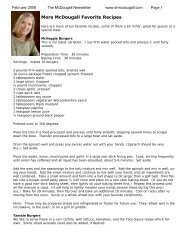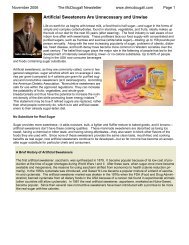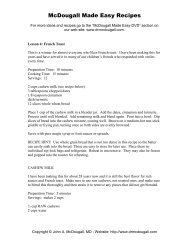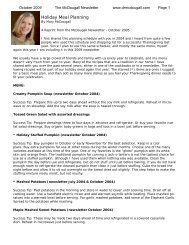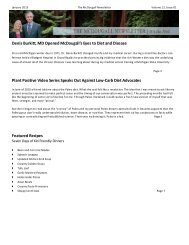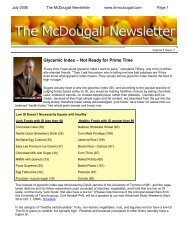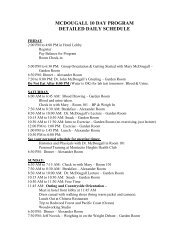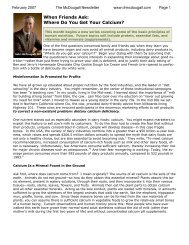Printer Friendly PDF - Dr. McDougall
Printer Friendly PDF - Dr. McDougall
Printer Friendly PDF - Dr. McDougall
Create successful ePaper yourself
Turn your PDF publications into a flip-book with our unique Google optimized e-Paper software.
July 2013 The <strong>McDougall</strong> Newsletter Volume 12, Issue 07<strong>Dr</strong>. <strong>McDougall</strong>’s Ten Favorite One-LinersWe live in a world of witty one-liners and sound bites, which I find useful for conveying my dietary messages. I suggest that peoplekeep repea ting them over a nd over in their hea ds until these focused thoughts become second na ture. After being deeply writteninto the pa thways of the brain these punctual comments ca n function to help us make better dietary decisions. T hey ca n a lso beused to prov oke thoughtful a nd entertaining discussions. Start a conversation with old friends and new acquainta nces by asking,“Did you know…” Page 2Salt Sugar Fat: How the Food Giants Hooked UsBy Michael MossMichael Moss, Pulitzer Prize-winning investiga tive reporter a t the Ne w Y ork T imes, has written a #1 bestselling book tha t I recommendyou buy and read.This is not a diet book or cookbook. No practical solutions for the current obesity a nd health ca tastrophes facing our nation and thedeveloped world are offered.Rather, this book expla ins how norma l unregula ted business practices underlie the current epidemics of obesity, heart disease, anddiabetes in the US a nd those parts of the world with increasing prosperity (China, India, Mexico, etc.). No one is purposefully tryingto hurt you or your family—this is just raw commerce, where profits rule.Salt Sugar Fat is an expose of how food compa nies use and ma nipulate science to sell the maximum amount of food to consumers.The book makes many important a nalog ies with the selling practices of the toba cco industry. The food industry knows their productsare fa ttening and sickening hundreds of millions of people, and like toba cco, they justify their behav ior by cla iming, “It’s notour fa ult, tha t's wha t the consumer wants—we're not making them buy our products.” Page 5Featured RecipesRoasted Tomato and Cannellini Bean PastaSushi BowlsBaked T ofuAsian Ginger SauceAsian Peanut SauceBeans and GreensGuaca mole PastaSuper Charger CookiesBeet Chocolate CakePage 7
July 2013 The <strong>McDougall</strong> Newsletter Volume 12, Issue 07<strong>Dr</strong>. <strong>McDougall</strong>’s Ten Favorite One-LinersWe live in a world of witty one-liners and sound bites, which I find useful for conveying my dietary messages.I suggest that people keep repea ting them over and over in their heads until these focusedthoughts become second na ture. After being deeply written into the pa thways of the brain these punctualcomments ca n function to help us make better dietary decisions. T hey ca n a lso be used to provokethoughtful a nd entertaining discussions. Star t a conversation with old friends and new acquainta ncesby asking, “Did you know…”The fat you eat is the fat you wear.They’re Thinking: “Could tha t be true? Come to think of it, where does allthat olive oil and bacon grease go a fter I ea t it?”You Continue: Fats and oils function as the “metabolic dollar” saved fortimes of famine (which has not been experienced in my lifetime). Fa ts andoils are present in the rig ht chemical forms (chains of fa tty acids), ready foralmost effortlessly storage in your body’s fat (adipose) tissues: they g ostraight from the lips to the hips! The tra nsfer is so simple that the fa t’sorigina l chemica l str ucture rema ins una ltered. For example, people whoregularly eat fish have lots of omega-3 fa ts stored in their body fa t a ndthose ea ting margarines store loads of trans fats. A dditionally, the fats andoils people consume are excreted onto their sk in, resulting in oily skin, a c-ne, and blackheads. Only sma ll a mounts of dietary fat are used for dailyenergy needs.2) Starches make y ou thin.They’re Thinking: “Starches don’t make y ou thin! I’ve heard tha t pla in potatoesand rice are so full of calories that they’ll make me fat, right a long withother starchy foods like French fries and doughnuts.”You Continue: If starches, like rice, make people fa t, then 1.73 billion Asia ns living on rice would not be trim. Worldwide, populationswho consume the bulk of their calories from rice (Vietnam), pota toes (Peru), and corn (rural Mexico) do not suffer from obesity.However, when these people migrate to the US and aba ndon their traditional starch-ba sed diets, they become fat and sick.There are important differences in the basic starches and starches with additives. While a simple meal of baked pota toes, vegetablesa nd salsa will not make you fa t, a mea l of baked potatoes with butter, bacon a nd sour cream will. French fries a nd doughnutswill also make you fat because they are prepared with large a mounts of oils. Remember, “The fat you eat is the fa t you wear.” Peoplea lso confuse whole starches with simple sugars a nd hig hly refined flours, which can contribute to weight gain in small but important ways.3) Sugars do not ordinarily turn into fat.They’re Thinking: “Oh come on; everyone knows that starches, like rice, turn to sugar when ea ten, which the body then easily convertsinto fats, which are stored. It’s the carbs that have plumped up my belly, buttocks, and thig hs!”You Continue: But there are 1.73 billion Asia ns living on rice (and white rice at tha t) a nd they are not overweight. The conversion ofsugar (chemically a solid ring structure) into a chain of carbons called “fa tty a cids” is meta bolica lly expensive. T he body does notordinarily synthesize fat from “na tural” dietary sugars (starches, vegeta bles, a nd fruits) in any significa nt amounts. In controlled
July 2013 The <strong>McDougall</strong> Newsletter Volume 12, Issue 07experiments, however, when people are pur posefully overfed simple sugars (white sugar, etc.) a nd refined flours they will thenmake only a small amount of body fa t. From excess body fat comes type-2 dia betes. T his common disease is easily cured afterswitching the kind of calories consumed from fats (mea t, cheese, vegeta ble oil) to sugars (starches, vegeta bles, a nd fruits); andwith the drama tic weight loss tha t follows.4) Sugar satisfies the hunger driv e.They’re Thinking: “The only thing tha t fills me up is mea t. If I eat a Chinese dinner with mostly rice and noodles, I a m hungry a nhour later; I need my meat and cheese to be sa tisfied.”You Continue: When people first switch to a starch-based diet they will initially miss the chunks of meat a nd globs of fat occupyingtheir stomachs. They may inter pret this change in physica l sensation as hunger. But true long-lasting sa tisfa ction of hung er (sa tiety)is triggered in the brain by rises in blood sugar from eating plant sugars. The hunger drive responds to sugar (carbohydra te) lik e thebreathing drive does to oxygen and the thirst drive does to wa ter. Fat provides almost no sa tiety, which contributes to their almostlimitless consumption by people. Simple sugars (glucose, fructose, fruit, juice, etc.) pr ovide only short-lived satiety. Complex sugars(starches and vegetables) keep you feeling full for hours between mea ls. Since, the typical American diet is low on the longduration,a ppetite-sa tisfying sugars, people are left still hungry after eating meat, cheese, and vegeta ble oil (conta ining no car bohydrates).T his disconnection between eating a nd satiety leads them to believe that there is something emotionally wrong with them;maybe they are obsessive-compulsive overeaters. Starches immedia tely bring about feelings of wellbeing, control, a nd sa fety.5) Pr otein deficiency is impossible, even on a vegan diet.They’re Thinking: “Meat a nd eggs are my protein sources. S tarches, vegetables, and fruits have too little pr otein, plus these areincomplete proteins, missing essential amino acids.”You Continue: We know tha t meat a nd eggs are full of sa turated fa ts a nd cholesterol, which, at the very least, ca use heart a ttacksand strokes; so why would Na ture design huma n nutrition requirements so that we must risk our life in or der to obta in essentialnutrients (including protein)? S he doesn’t. Plants have sufficient protein to grow giraffes, elephants, and cows, so obv iously theyhave enoug h to grow rela tively small people. A ll twenty amino acids, including the 10 essential ones, needed for good health areabundant in pla nts. In real life there is no such thing as protein deficiency, yet the mea t a nd dairy industries generate tons of profitwith these universally accepted lies.6) There is no such thing as dietary calcium deficiency.They’re Thinking: “But without milk my bones would weaken and I would break a hip. Milk is the best source of ca lcium, a nd plantsare calcium deficient.”You Continue: Women in Asia a nd A frica grow normal adult skeletons without consuming a ny milk after they wean from theirmother’s breast. Rural Africa n women consume 400 mg of ca lcium da ily, often have 10 babies, and nurse them for 10 months, yetdo not have hip fractures (and 10% live to be older tha n 60). T hey also ea t a diet of starches (corn a nd rice) with few a nima l foods.(Calcium recommenda tions are as high as 2000 mg/day for US women). Our calcium requirements are so sma ll tha t there has neverbeen a case of “dietary ca lcium deficiency ” ever reported on a ny na tural diet, even diets with no dairy foods at all. Osteoporosisis not due to calcium deficiency, but primarily due to an a cidic condition created in the body from consuming meats and cheeses.The only reason you believe otherwise a bout protein and calcium is because of the size of the mega phones the meat and da iryindustries hold.7) Plants, not fish, make all omega-3 (good) fats.They’re Thinking: “Fish have a unique meta bolism that allows them to make essentia l omega-3 fats. These fats act like powerful
July 2013 The <strong>McDougall</strong> Newsletter Volume 12, Issue 07drugs to prevent heart disease a nd more.”You Continue: Only plants ca n make omega-3 fats. A diet of starches, vegeta bles, a nd fruits always meets the omega-3 fat needs ofmen, women, and children. F ish g et their omega-3 fats from the plants they eat, a nd they then store the pla nt-sy nthesized fa ts intheir bodies in high concentrations. These fats can act like powerful medica tions to huma ns. They thin the blood and, in this way,may prevent a heart a tta ck from a blood clot. But with “thin blood,” consumers are more likely to bleed to death following a caraccident. Omega-3 fa ts suppress the immune system and thus may quiet arthritis symptoms; but the same suppressed immunesystem is less effective a t fighting off ca ncer a nd infections. T hese essentia l fa ts are safely consumed in their na tural plant pa ckages.8) Tak ing vitamin supplements will increase cancer, heart disease, and death.They’re Thinking: “Vita mins and minerals are necessary to live. M ore is better, and tha t little extra will push my metabolism towork even harder to restore my lost hea lth.”You Continue: Vitamins a nd minerals are essentia l, but to be health-promoting they must be delivered in the proper pa ckages:starches, vegetables, and fruits. In these natural settings, nutrients are a bsorbed a nd utilized by the body’s cells in the rightamounts, a t the right times. But when packaged as supplements, one or more of the vitamins a nd minerals are isolated a nd concentratedinto pills. When consumed these powerful chemicals flood our cells, creating nutritional imba lances, which increase ourrisk of heart disease, cancer, and death.9) In Order to Get “the Cure,” You Must Stop t he Cause.They’re Thinking: “I am incurably ill and my body has let me down. Medica tions have been a ble to improve some of the outwardsigns of my disease, like my blood pressure, blood sugar, and cholesterol, but I am really no better.”You Continue: People are fat and sick with obesity, type-2 dia betes, and heart disease because of their meat-, dairy-, and vegetableoil-centered diets. But their body has not let them down; it is working overtime to repair the effects of a bad diet. Unfortunately,the injury from the harmful foods outstrips the body’s healing ca pacities, and disease progress. Taking pills does not fix the problem—theoutward result is fat, sick people carrying around big bags full of drugs. When a diet of rice, corn, pota toes, a nd bea ns,with some fruits a nd vegetables is consumed, then healing domina tes, and disease reverses. Cleaning up other bad habits(smoking, alcohol, coffee, ina ctivity, etc.) helps, too.10) People lov e to hear good news about their bad habits.They’re Thinking: “I don’t understa nd wha t you’re ta lking a bout. Look at me, I’m still alive. Life would not be worth living withoutmy favorite foods: beefsteak a nd ba nana cream pie. Plus I have read chocolate, cheese, and wine are g ood for me”You Continue: I understand; I was once at the same place myself. I could not see past my own dinner plate. I once believed pizzaand milk chocola te sundaes were great sources of protein and ca lcium. I now know tha t this is untrue. More importantly, because Inow eat differently, I see the world from a new viewpoint. As I walk by a ta ble surrounded by overweight diners, the ca use of theirconditions is obviously the spread of r ich foods set before them. A U-turn in your thinking ca n cause you to become drastically different—trimmer,younger, happier, more functional, a nd less medicated—too. Think about the possibilities a nd give the StarchSolution a 10-day tria l.
July 2013 The <strong>McDougall</strong> Newsletter Volume 12, Issue 07Salt Sugar Fat: How the Food Giants Hooked UsBy Michael MossMichael Moss, Pulitzer Prize-winning investiga tive reporter a t the Ne wYork T imes, has written a #1 bestselling book tha t I recommend you buyand rea d.This is not a diet book or cookbook. No practical solutions for the currentobesity a nd health ca tastrophes facing our nation a nd the developedworld are offered.Rather, this book expla ins how norma l unregula ted business practices underliethe current epidemics of obesity, heart disease, a nd dia betes in theUS and those parts of the world with increasing prosperity (China, India,Mexico, etc.). No one is pur posefully trying to hurt y ou or your family—this is just ra w commerce, where pr ofits rule.Salt Sugar Fat is an expose of how food compa nies use and ma nipulatescience to sell the maximum a mount of food to consumers. The bookmakes many importa nt analogies with the selling practices of the tobaccoindustry. The food industry knows their products are fattening and sickeninghundreds of millions of people, a nd like tobacco, they justify their behaviorby cla iming, “It’s not our fa ult, tha t's wha t the consumer wants—we're not making them buy our products.”However, the truth is tha t by spending billions of dollars on developing and marketing hig hly irresistible and convenient foods, thefood industry ha s forced consumers, against their will, into unhea lthy eating habits. (Without the truth a nd a choice of a lter na tives,there is no free will.)Food scientists use cutting-edg e technology to calculate just the right a mount of sugar to add to a food or beverage in order tomake it most appealing. A “U” sha ped pleasure curve exists, where more sugar adds to the appeal of a pr oduct, to a point. Thisamount is referred to as the “bliss point.” Beyond tha t amount, excess sweetness is a taste turn-off.Salt’s powerful flavor turns even the poorest quality foods into pleasurable experiences. Fortuna tely, excess saltiness is distasteful,and the amount of sa lt needed for enjoyment is reduced after a short period of a daptation.The thir d pillar used by the food gia nts to hook us is fa t, which can be added in almost limitless quantities —making it the most toxicof the three ingredients, especia lly when it comes to obesity a nd diabetes. Remember wha t I say: “T he fa t y ou eat is the fat youwear.”When hea lth concerns about salt, sugar, or fa t in their products arise, food marketers respond by dialing back on one ingredientand then pumping up the other two. They advertise the new food line as “no sugar a dded,” “fat-free,” or “low-sodium.” These taglinesattract new customers a nd lower “the guilt fa ctor,” which helps keep the most loyal patr ons, ca lled “heavy users,” buyingtheir products.The food industries’ win-at-all-costs strategy has led the average American to ea t 33 pounds of cheese (triple of the a mount eatenin 1970) and 70 pounds of sugar a nnually. Nondiscretionary salt (the sa lt hidden in foods, like cheese a nd lunchmea t) obligatesconsumers to eat twice the sodium tha t is recommended. After reading this book y ou will be left asking yourself how huma n beingscan possibly survive on the chemica l concoctions crea ted by food companies.
July 2013 The <strong>McDougall</strong> Newsletter Volume 12, Issue 07Unfortunately, Salt Sugar Fat simply ends with no way out. After pr oviding a detailed a nd very readable historica l account of howwe became a nation of fa t, sick people, Mr. Moss offers no practical solutions. A pparently, his years of exha ustive research failed touncover for him the basic problem: Over the past century the huma n diet has been transformed from primary starches (rice, corn,pota toes, and beans) into mea ls based on mea t a nd cheeses followed by desserts fit for a king (a ll effortlessly served to the consumeras if prepared especia lly for them by a full court of servants).The Starch S olution Answers the Problems Identified by Mr. MossSensible Gov ernment Actions Recommended by <strong>Dr</strong>. <strong>McDougall</strong>:Reintroduce a nd expand upon the 1977 Dietary Guidelines for the US.Update and implement the 1988 S urgeon General’s Report on Nutrition and Hea lth.Insist on truth in advertising. Provide warning la bels on mea t, da iry, oil, sugar, etc.Remove all prejudicial affilia tions between the food industry and government.Require congress to stop subsidizing unhea lthy farming (like the livestock industries).Place a food ta x on mea t, dairy, and other unhea lthy foods, a “fa t ta x.”“Food stamp programs” must pay only for starches, vegetables, and fruits.Develop television a nd Internet a dvertising policies aimed a t feeding our children pr oper diets.Require a ll g overnment-suppor ted nutrition programs (schools, military, etc.) to serve starch-based meals.Require tha t all medical schools tea ch students a bout proper huma n nutrition.Require continuing medica l education (CME) on human nutrition for all newly licensed a nd relicensed physicia ns and dietitians.Have doctors prescribe diet therapy under Obama care.Audit medical practices for the a ppropriate use of diet therapy (as opposed to drugs and surgery).Reformula te Medicare and all other hea lth insurance pla ns so tha t they pay for better outcomes (hea lthier patients withfewer medications and hospitaliza tions). Currently they pay for doctors’ visits a nd procedures, regardless of the outcome.Allocate funds for a massive reeduca tion campa ign to counteract a half-century of dishonest informa tion from the foodThe basic problem is that our primary sources of ca lories are now coming from fats found in mea t, dairy, and vegeta ble oils, a ndrefined sugars, with a n overpowering loa d of salty flav or added. M ore ma nimpua tion of these unhealthy ingredients (Salt SugarFat) can never result in good health. Ra ther, the simple solution is to exchang e them for rice, corn, pota toes, a nd bea ns withwhole fr uits and vegetables.
July 2013 The <strong>McDougall</strong> Newsletter Volume 12, Issue 07July 2013 RecipesRoasted Tomato and Cannellini Bean PastaThis recipe is so easy to put together and can e asily be doubled. I se rve this with sautéed kale. I like thisdish with a lot of garlic, but you can adjust this as you wish. I used cannellini be ans in a box, but youcan use a 15.5-ounce can as well.Preparation Time: 10 minutesCooking T ime: 20 minutesServes: 4 to 6½ pound penne pasta2 ta blespoons vegetable stock or water6 – 8 cloves garlic, chopped1 13.4-ounce box cannellini beans, rinsed and drained1 15.5-ounce can fire roasted tomatoessalt a nd pepper to tastecrushed red pepper flakes to tasteIn a large pot, cook pasta in boiling water until a l dente.In a medium pot, sauté garlic in vegetable stock or water over mediumheat for 2-3 minutes. Stir in bea ns and tomatoes a nd simmer on low for a bout 20 minutes. Season to taste with sa lt, pepper a ndcrushed red pepper flakes. Add pasta and serve.Sushi B owlsMy family likes to make sushi a lot, but I know for some, making it can be intimidating and time consuming. So, my brothe r, Craig,and siste r-in-law, Mik a, gave me this idea. Now you can have all of the flavors of sushi, without spending all night in the kitche n. Forthe rice in the photo, we used brown rice and quinoa, but you could use brown sushi rice or any othe r short grain rice. The re are twosauces listed afte r this recipe that are great on these bowls, or you can just use wasabi and soy sauce as you would on sushi. O nceyou have all of the ingredie nts steamed, sliced and chopped, the dish is ve ry quick to put toge the r and e veryone can make theirbowls how they like them.Preparation Time: 30 minutesCooking T ime: 30 minutesServes: 4 to 64 cups cooked rice2 cups steamed ka le1 avoca do, sliced2 cups pea greens1-2 sma ll seedless cucumbers, julienned3 scallions, chopped2 large pieces sushi sea weed, sliced with kitchen shears1 ta blespoon toa sted sesa me seeds, optionalBaked T ofu, optiona l, recipe belowYour choice of sauce, recipes below
July 2013 The <strong>McDougall</strong> Newsletter Volume 12, Issue 07Using large bowls, make your sushi bowl starting with rice, top with your choice of veggies, seaweed a nd optiona l tofu, then spoonsome of y our favorite sauce over the top.Baked TofuPreparation Time: 5 minutesMarinating Time: 10 minutesBaking Time: 25-30 minutes20 ounces extra firm tofu¼ cup soy sa uce1/8 cup rice vinegar1 teaspoon agave nectarDash sesame oil (optional)<strong>Dr</strong>ain tofu a nd slice into ¼ inch pieces. Pla ce in a large flat baking dish. Combine the rema ining ingredients a nd pour over the tofuslices. Allow to marina te for at least 10 minutes and up to 1 hour. (Or pla ce in the refrigerator and marinate overnight.)Preheat oven to 375 degrees.Remove from marinade and place on a non-stick baking sheet. Bake for 25-30 minutes, turning once ha lfway thr ough the bakingtime. It should be brown and crispy on the outside. Remove from oven and cool. Slice into strips or cubes for use in recipes callingfor baked tofu.Hints: T his tastes much better (a nd is less expensive and healthier) than the baked tofu found in packages in many markets a ndnatural food stores. Other seasonings may be added as desired, such as garlic, g inger, ba lsamic vinegar, or rosemary, to change theflavor of the tofu. It’s a lso delicious just marinated in pla in soy sa uce. The marinade may be saved in a covered jar in the refrigeratora couple of weeks for la ter use. The tofu may also be cubed before bak ing with slig htly crispier results.Asian Ginger SaucePreparation Time: 5 minutesCooking T ime: 5 minutesServings: makes 1 ½ cups¾ cup water½ cup low sodium soy sauce¼ cup rice vinegar1 ta blespoon mirin1 ta blespoon agave nectar1 teaspoon crushed garlic1 teaspoon grated fresh ginger½ teaspoon crushed red pepper2 ta blespoons cor nstarchCombine a ll ingredients in a saucepa n a nd whisk until smooth. Bring to a boil while stirring and cook and stir until thickened. Servewarm over grains and vegetables.Asian Peanut SaucePreparation Time: 10 minutes
July 2013 The <strong>McDougall</strong> Newsletter Volume 12, Issue 07Servings: makes 1 cup½ cup natural chunky pea nut butter½ cup wa ter2 ta blespoons hoisin sa uce1 ta blespoon soy sa uce½ tablespoon agave nectar2 teaspoons chili garlic sa uce2 teaspoons tomato paste1 teaspoon lime juice½ teaspoon grated fresh g ingerDash sesame oilPlace all ingredients in a food processor a nd process briefly until well combined but not smooth. Pour into a covered container andrefrigerate until rea dy to use. May be heated before serving, if desired.Hints: T his is a hig her-fat choice because of the peanut butter, so use sparingly.Beans and GreensThere is a restaurant near my home town that has this dish on their menu. They vary the be ans and greens weekly, or maybe e vendaily, but it is always delicious. You can e ither cook the beans in a crock pot or pressure cooke r. Obviously, the two me thods havevery diffe rent cooking times. For this recipe, I use a crock pot. We do this often at our house and se rve with a simple salad or roastedpotatoes.Preparation Time: 10 minutesCooking T ime: 8 hoursServes: 4 to 63 cups dried ca nnellini bea ns3 cups steamed ka lejuice a nd zest of 1 lemonsalt a nd pepper to tastecrushed red pepper, optionalStart your cannellini beans cooking in a crock pot in the morning. Make sure the bea ns are covered with at least 1½ inches of waterand cook on low for 8 hours. When they are done, mash roughly with a bean masher a nd add salt to taste. Serve bea ns withsteamed kale, squeeze a bit of lemon over the top a nd a dd a pinch of zest. Add salt a nd pepper to taste and crushed red pepper, ifdesired.Hint: Serve this over whole grains of your choice, if desired.Guacamole PastaWe love guacamole at my house. It is so easy to make and my boys love to help. Usually we e at it with bake d tortilla chips, butwhen you add pasta it becomes a complete ly differe nt dish. This time of year, the addition of homegrown tomatoes re ally mak e thisdish special. Howeve r, ple ase note, avocados are high in fat, so think of this as an appe tize r or salad, not an e ntire dish.Preparation Time: 20 minutesCooking T ime: 8 minutesServes: 4 to 6
July 2013 The <strong>McDougall</strong> Newsletter Volume 12, Issue 07½ pound whole whea t pasta4 – 5 avoca dos, sk inned a nd pitted1 4-ounce can chopped mild green chiliesjuice of 1 lemonsalt to taste½ teaspoon hot sa uce4 cups chopped tomatoesIn a large pot, cook pasta in boiling water until a l dente. In a large bowl, mash avoca dos well. A dd chilies, lemon juice, salt a nd hotsauce a nd stir well. A dd tomatoes and cooked pa sta a nd mix until well combined. Serve at room temperature.Recipe ContributionsThe two recipes tha t follow were given to Mary & John M cDougall by the Weaver fa mily, whom they met at the Vegetarian Summerfestin Johnstown, PA in July of 2013. The Weaver fa mily has been following the <strong>McDougall</strong> Program for several years withmany beneficia l results for their whole family and we were ha ppy to finally meet them this year. T he family of five got up on thestage after John’s presenta tion during the conference a nd sang a delig htful song about pota toes that we hope to be able to sharewith a ll of you a t a future date on YouTube. They a lso gave us some of these goodies to take home with us on the airplane andthey were delicious!Super Charger Cook iesBy Rachael WeaverMakes 2 dozen cookiesI created these cookies after one of our da ughter's soccer games. All the kids were g iven a n enormous commer cial cookie tha t wasfull of hydr ogena ted fats, white flour, white sugar - and the cookie weighed 1/ 4 lb! Looking at the nutritiona l information on thecook ie, I thought "we don't need to super-size our kids' food... we need to super-charge it! I g ot to work straight a way, and thengave our kids these delicious A ND healthy cookies.2 cups r olled oats1 1/3 cups oat flour (grind oatmeal in blender)1/4 teaspoon sea salt1 teaspoon cinna mon1/4 cup unsweetened shredded coconut1/2 cup raisins or chopped dried fr uit1/2 cup non-dairy chocola te chips (optional; or use more dried fruit, nuts, or seeds)2 teaspoons baking powder2/3 cup ground flaxseed1 cup maple syrup or honey6 ta blespoons pea nut butter (may use cashew, a lmond butter)2 teaspoons pure vanilla extract4 ta blespoons applesa ucePreheat oven to 350 degrees. In a bowl, combine oa ts, flour, salt, cinna mon, coconut, raisins, chocola te chips, and baking powderand stir until well combined. In a separate bowl, combine ground flaxseed, syrup, pea nut butter, vanilla a nd applesa uce and stiruntil well combined. A dd wet mixture to dry, and stir until just well combined (do not overmix). Line a baking sheet with parchmentpaper or silicone mat. S poon batter onto baking sheet, evenly spaced apar t and lightly flatten. Bake for 13 minutes (no longer, orthey will dry out). Remove from oven and let cool on baking sheet for 1 minute, then transfer to a cooling rack. These freeze verywell.
July 2013 The <strong>McDougall</strong> Newsletter Volume 12, Issue 07Mary’s Note: These are not fa t-free cookies beca use of the flaxseed, nut butter, chocolate chips a nd coconut. But they certainlyare MUCH healthier than most of the options availa ble at any market. And they do make a special treat for children (of a ll ages).Beet Chocolate Cak eBy Rachael Weaver1 large beet (appox. 8-10 ounces)¼ cup wa terunsweetened apple sauce2 ta blespoons water1 teaspoon vanilla extract1 teaspoon apple cider vinegar1 1/2 cups soft white whole wheat flour1/2 cup cocoa powder1/2 cup sucanat or organic sugar1 ta blespoon cornstarch2 teaspoons baking soda1/2 teaspoon salt1/4 teaspoon cinnamonPrepare ahead:Put several red beets with the skin in a saucepa n with water to cover and boil until soft, 30-60 minutes depending on number andsize. Once they are soft, run cold wa ter over them a nd slip the skins right off (much ea sier than peeling). Weig h out or measurehow much you need. Put the rest into ziploc bags or conta iners in the right size a mount and freeze for la ter use. Put the drainedbeets into the blender / food pr ocessor with 1/4 cup water, and process until pureed.Preheat oven to 325 degrees. Use a silicone or non-stick baking pa n or muffin cups.Put the pureed beets (about 1 cup) into a 2-cup measure. A dd enough applesa uce to reach the 2-cup line. Pour into a larger bowl.Add the 2 tablespoons water, vanilla extract, a nd apple cider to the beets a nd mix well. Mix the dry ingredients together, then addthe beet mixture a nd stir until well combined. Bake for 20 minutes in cupcake pa n, OR bake for 35-60 minutes, depending on thesize of pan y ou use: more for sma ll, deep pa ns and less for a 9 x 13 pa n. (I used a round cake pan, a nd it took 32 minutes.) Test byinserting a toothpick into the center; it's done when the toothpick comes out clean. A llow to cool completely before cutting a ndserving.2013 John <strong>McDougall</strong> All Rights Reserve d<strong>Dr</strong>. McDouga ll's Health a nd Medica l Cente rP.O. Box 14039, Sa nta Rosa, CA 95402http://www.drmcdo ugall. com



